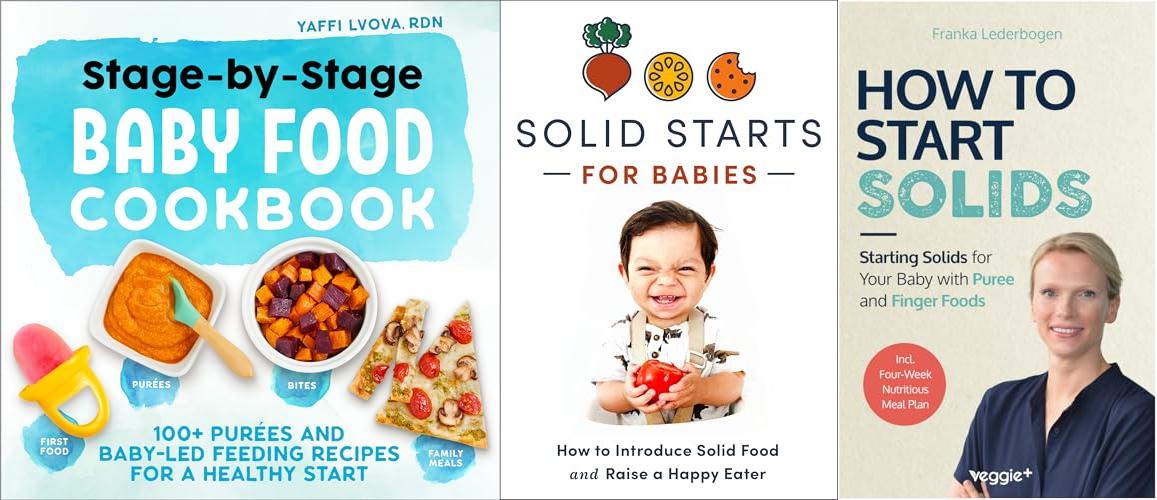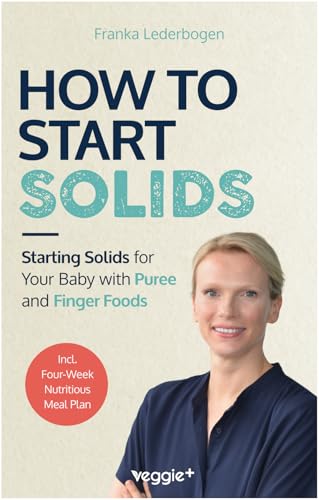Is your little one ready for their first taste of solid food? The thought of introducing purees can be exciting, but it can also feel a little overwhelming. So many choices, so many different opinions – where do you even begin?
Choosing the right first purees for your baby is a big step, and it’s completely normal to feel unsure. You want to give them the best start, packed with nutrients and flavors they’ll love, but the sheer volume of information out there can make it tough to navigate. What’s safe? What’s nutritious? What will they actually eat?
This post is here to help! We’ll break down the best purees to start with, offering clear, simple advice to build your baby’s palate with confidence. You’ll learn about easy-to-digest options, how to introduce new flavors, and what to look out for to make feeding time a joyful experience for both of you.
Our Top 5 Purees To Start With Baby Recommendations at a Glance
Top 5 Purees To Start With Baby Detailed Reviews
1. Stage-by-Stage Baby Food Cookbook: 100+ Purées and Baby-Led Feeding Recipes for a Healthy Start
Rating: 8.6/10
Starting your baby on solid foods is a big adventure! The “Stage-by-Stage Baby Food Cookbook: 100+ Purées and Baby-Led Feeding Recipes for a Healthy Start” makes this journey exciting and manageable. This cookbook guides you through feeding your little one from their very first tastes to more complex meals. It offers a wide variety of recipes, ensuring your baby gets delicious and nutritious food as they grow.
What We Like:
- Offers over 100 recipes, giving you tons of options.
- Covers both traditional purées and baby-led weaning methods.
- Recipes are broken down by stage, making it easy to follow.
- Focuses on healthy ingredients for your baby’s development.
- Includes helpful tips for introducing new foods.
What Could Be Improved:
- Some recipes might require special kitchen tools.
- Could benefit from more visual aids or pictures for each recipe.
This cookbook is a fantastic resource for parents. It empowers you to create healthy and enjoyable meals for your baby.
2. Solid Starts for Babies: How to Introduce Solid Food and Raise a Happy Eater
Rating: 9.5/10
The “Solid Starts for Babies: How to Introduce Solid Food and Raise a Happy Eater” guide is your go-to resource for navigating the exciting world of baby-led weaning and traditional purees. It offers practical advice and helpful tips to make feeding time a positive experience for both you and your little one. This guide aims to empower parents with the knowledge to confidently introduce a variety of healthy foods, fostering a lifelong love for nutritious meals.
What We Like:
- Provides clear, step-by-step instructions for introducing solids.
- Offers a wide range of recipe ideas suitable for different stages of development.
- Addresses common concerns and challenges parents face.
- Encourages a positive and stress-free approach to feeding.
- Helps babies develop good eating habits early on.
What Could Be Improved:
- Could include more visual aids or photos to demonstrate techniques.
- Might benefit from a section on common allergens and how to introduce them safely.
- Some advanced topics could be explored in greater depth for experienced parents.
This guide is an invaluable tool for any parent starting their baby’s solid food journey. It equips you with the confidence and knowledge to raise a happy and adventurous eater.
3. How to Start Solids: Starting Solids for Your Baby with Puree and Finger Foods (The Basic Book for Starting Solid Food and Baby-Led Weaning
Rating: 8.5/10
Navigating the exciting world of starting solids with your baby can feel overwhelming. The “How to Start Solids: Starting Solids for Your Baby with Puree and Finger Foods” book offers a clear and straightforward approach. It covers both traditional purees and the increasingly popular baby-led weaning method. This guide is designed to be a basic, essential resource for parents embarking on this new journey. It even includes a helpful 4-week plan to help you get started.
What We Like:
- It clearly explains both puree feeding and baby-led weaning.
- The 4-week guide makes it easy to plan meals.
- The book is a good starting point for new parents.
- It focuses on the basics, which is helpful.
What Could Be Improved:
- More in-depth recipes could be included.
- Visual aids for different food textures would be beneficial.
- Tips for dealing with common picky eating scenarios are missing.
- Information on choking hazards could be more detailed.
This book provides a solid foundation for parents looking to introduce solid foods. It simplifies the process and offers a practical starting point for your baby’s culinary adventures.
4. The Ultimate Baby Food Cookbook: 2000 Days of Nutrient-Dense Baby Purées
Rating: 9.2/10
Feeding your little one can feel like a big adventure! The Ultimate Baby Food Cookbook is your guide for this journey. It offers 2000 days of yummy and healthy recipes. You’ll find purées for babies, fun finger foods, and meals for growing toddlers. This cookbook helps you give your child a great start with good nutrition at every stage. The full-color edition makes it even more exciting to explore all the delicious options.
What We Like:
- Offers a huge variety of recipes covering purées, finger foods, and toddler meals.
- Provides a clear path from the first bites to more complex toddler dishes, lasting for 2000 days.
- The full-color edition makes the recipes visually appealing and easy to follow.
- Focuses on nutrient-dense options to support healthy development.
- Covers a wide age range, making it a resource that grows with your child.
What Could Be Improved:
- The sheer volume of recipes might feel overwhelming for some new parents.
- Could benefit from more information on common allergies or dietary restrictions for each recipe.
This cookbook is an excellent resource for parents who want to make healthy, homemade food for their children. It simplifies the process of feeding your baby from start to finish.
5. Baby-Led Feeding: A Natural Way to Raise Happy
Rating: 9.4/10
The book “Baby-Led Feeding: A Natural Way to Raise Happy, Independent Eaters” guides parents through a popular feeding method. It explains how babies can feed themselves right from the start. This approach helps babies learn to eat on their own. It encourages them to explore different foods and textures. The book aims to make mealtime a positive experience for everyone.
What We Like:
- Encourages baby’s independence at mealtime.
- Promotes healthy eating habits from an early age.
- Helps babies develop fine motor skills as they grasp food.
- Can make meal prep simpler for parents.
- Focuses on natural development and baby’s cues.
What Could Be Improved:
- Can be messy in the beginning stages.
- Requires careful selection of safe food sizes and shapes.
- Some parents may worry about choking hazards without proper guidance.
- Might not be suitable for all babies or family situations.
This book offers a fresh perspective on feeding babies. It empowers parents to trust their child’s abilities and foster a love for food.
Purees to Start With: A Parent’s Guide
Starting your baby on solid foods is an exciting milestone! Choosing the right purees makes this transition smoother and healthier. This guide will help you pick the best options for your little one.
Key Features to Look For
When buying purees, several things matter.
Nutrient Density
- Look for purees packed with vitamins and minerals. This helps your baby grow strong.
- Single-ingredient purees are often best at first. They let you see how your baby reacts to each food.
- Good options include sweet potato, carrot, peas, and apple.
Texture and Consistency
- New eaters need smooth purees. They should be easy to swallow.
- Avoid purees with chunks or lumps initially.
- As your baby gets older, you can try slightly thicker purees.
Absence of Additives
- Purees should have no added sugar or salt. Babies don’t need these.
- Check the ingredient list. It should be short and simple.
- Artificial colors and preservatives are also a no-go.
Important Materials
The ingredients are the most important “materials” in baby food.
Single Fruits and Vegetables
- Puree made from just one fruit or vegetable is ideal.
- This makes it easy to introduce new flavors.
- It also helps you spot any allergies or sensitivities.
Whole Grains
- Oatmeal and rice cereal are common first foods.
- Choose whole grain options for more fiber.
- These provide energy for your growing baby.
Lean Proteins
- Once your baby is ready, you can introduce pureed chicken, turkey, or beans.
- These provide important building blocks for their body.
Factors That Improve or Reduce Quality
What makes a puree great or not so great?
Processing Methods
- Steaming vegetables before pureeing helps keep nutrients.
- High heat can destroy some vitamins.
- Look for brands that mention gentle processing.
Source of Ingredients
- Organic ingredients are a plus. They mean fewer pesticides.
- Knowing where the food comes from gives you peace of mind.
- Some brands are transparent about their sourcing. This is a good sign.
Packaging
- Glass jars are a good choice. They don’t leach chemicals.
- BPA-free plastic pouches are also safe.
- Avoid packaging that seems flimsy or damaged.
User Experience and Use Cases
How do parents and babies use these purees?
Ease of Use
- Pre-made purees are incredibly convenient.
- You can take them on the go for outings or travel.
- Pouches are especially good for busy parents.
Introducing New Flavors
- Purees make it simple to offer a variety of tastes.
- Babies can try many different fruits and vegetables.
- This helps them develop a broad palate.
Homemade vs. Store-Bought
- Some parents prefer to make their own purees. This gives them full control.
- However, store-bought purees are a great backup. They are time-saving.
- You can also combine both approaches.
Frequently Asked Questions (FAQ)
Q: What are the main Key Features to look for in baby purees?
A: You should look for nutrient-dense purees, a smooth texture, and the absence of additives like sugar and salt.
Q: What are the important materials or ingredients I should prioritize?
A: Prioritize single fruits and vegetables, whole grains, and lean proteins. Keep the ingredient list simple.
Q: What factors improve the quality of baby purees?
A: Gentle processing methods like steaming, using organic ingredients, and transparent sourcing improve quality.
Q: What factors can reduce the quality of baby purees?
A: High-heat processing, added sugars or salts, and artificial additives reduce quality.
Q: How do parents typically use these purees?
A: Parents use them for easy meal preparation, introducing new flavors, and for convenient feeding on the go.
Q: Can I give my baby purees with multiple ingredients right away?
A: It’s usually best to start with single-ingredient purees. This helps you identify any potential allergies.
Q: Are organic purees better than conventional ones?
A: Organic purees are often preferred because they have fewer pesticides. However, conventional purees can still be a healthy choice.
Q: How should I store opened baby food purees?
A: Refrigerate any unused portion in a sealed container. Most purees last 2-3 days in the fridge.
Q: What is the best way to introduce new purees to my baby?
A: Offer one new puree at a time. Wait a few days before introducing another to check for reactions.
Q: Can I mix purees with breast milk or formula?
A: Yes, you can mix purees with breast milk or formula to thin them out and make them more familiar to your baby.
In conclusion, every product has unique features and benefits. We hope this review helps you decide if it meets your needs. An informed choice ensures the best experience.
If you have any questions or feedback, please share them in the comments. Your input helps everyone. Thank you for reading.






